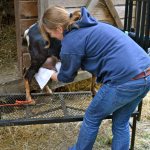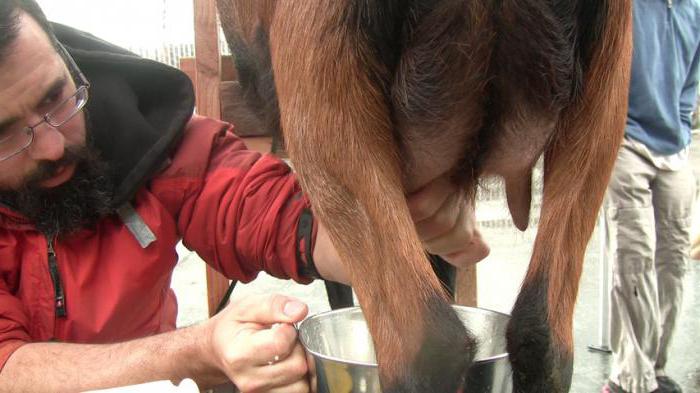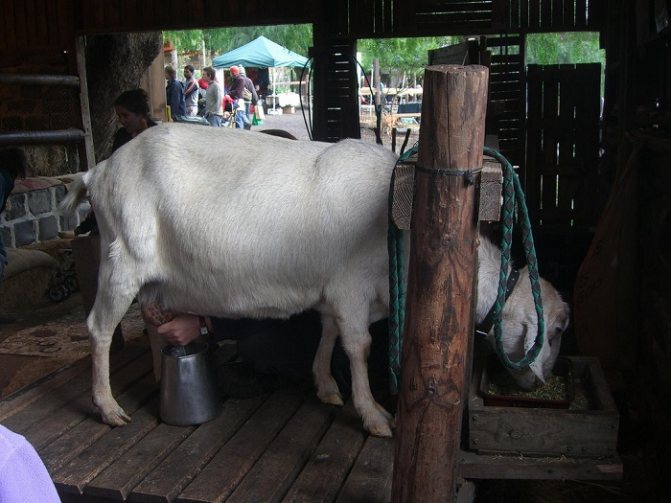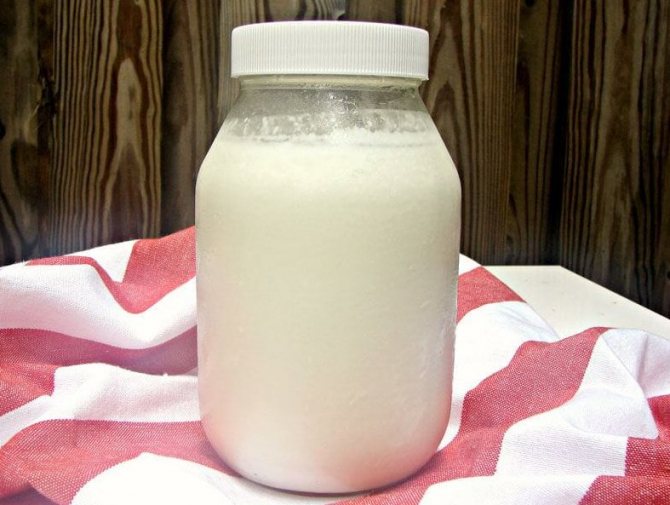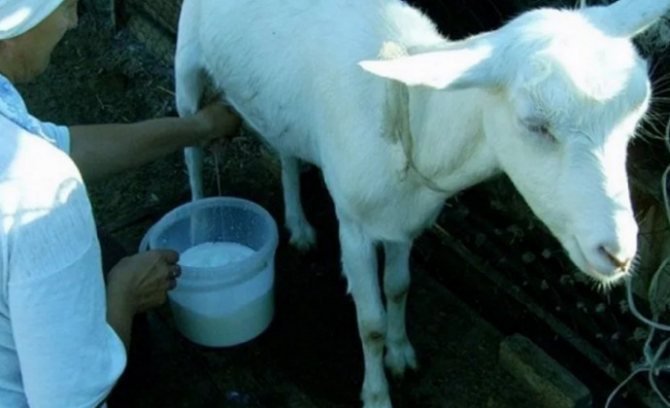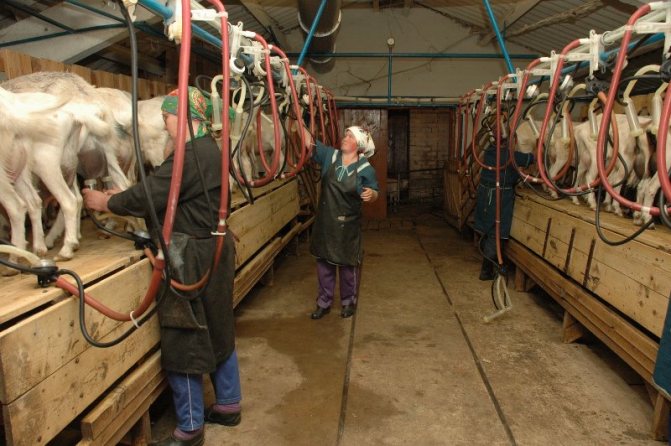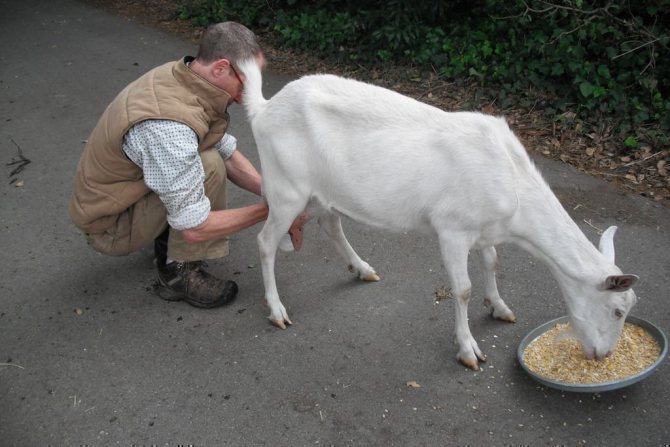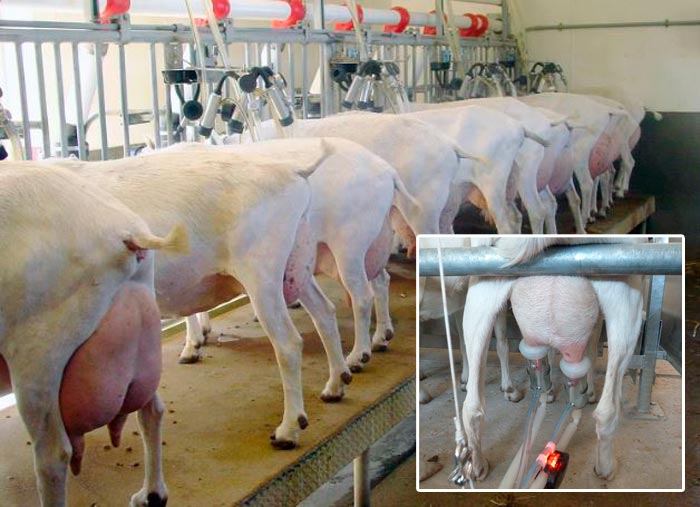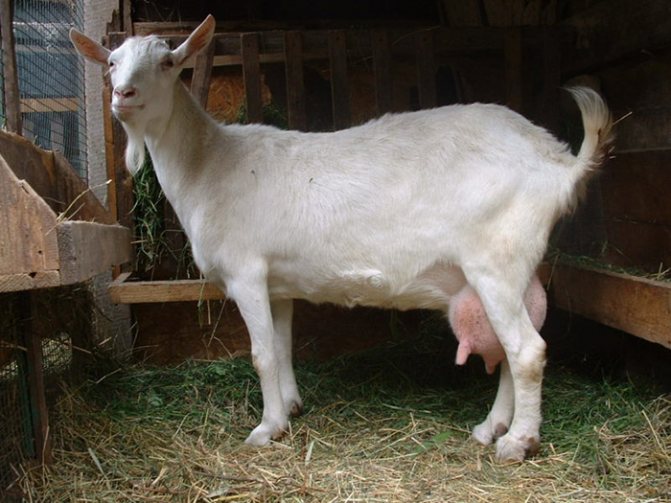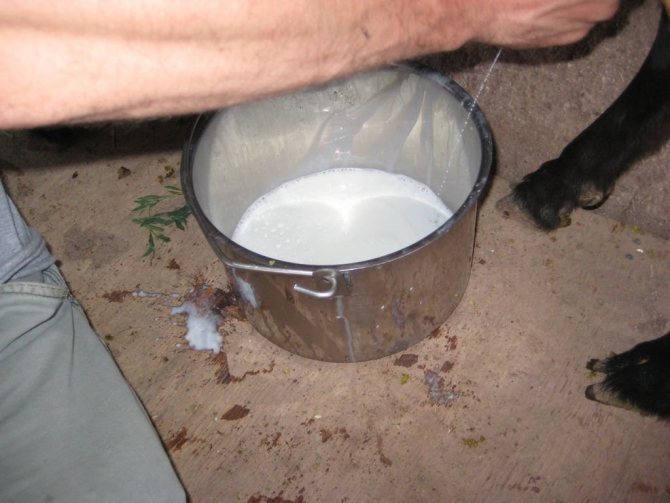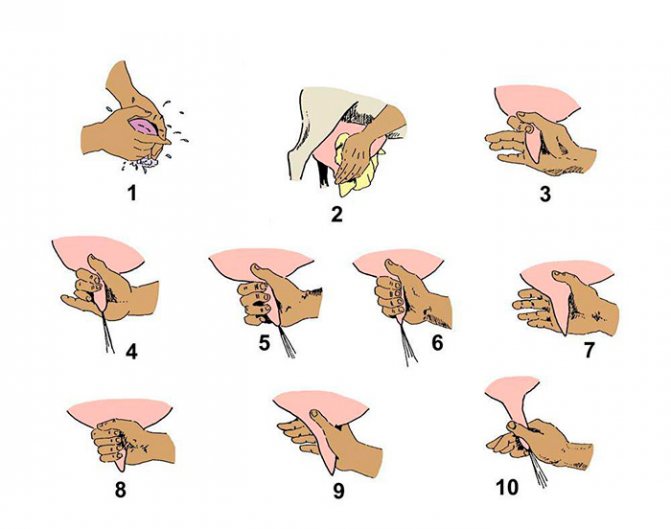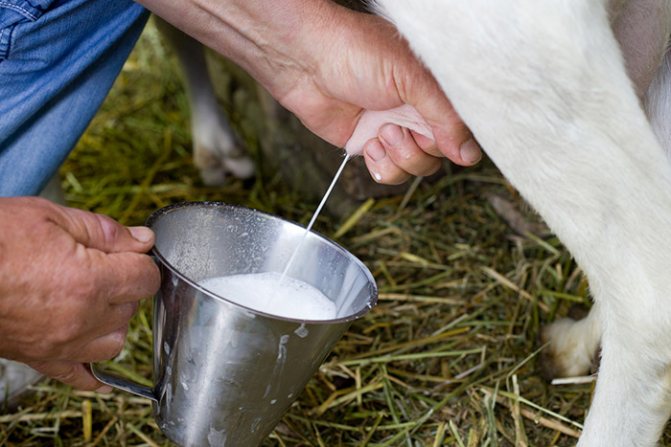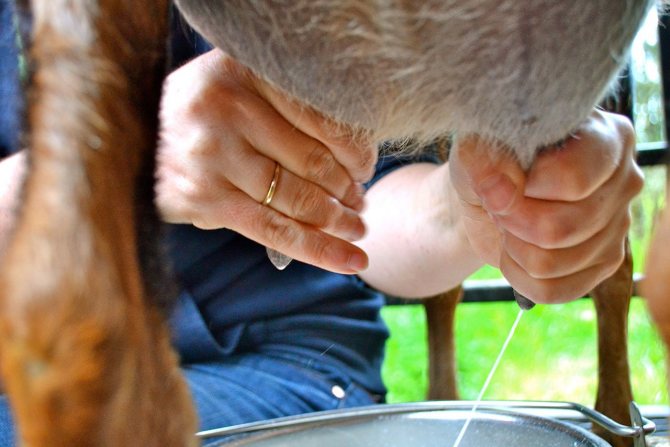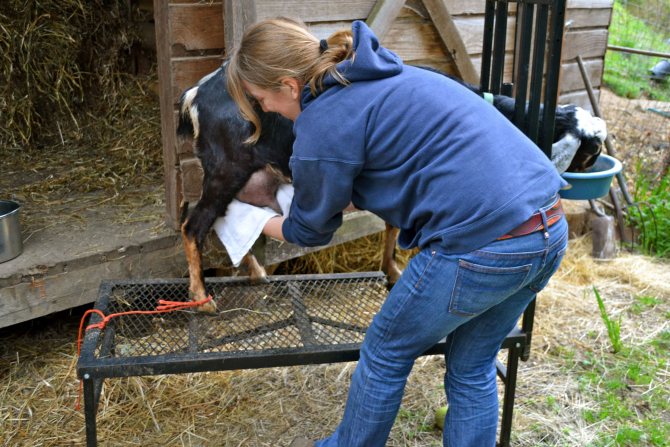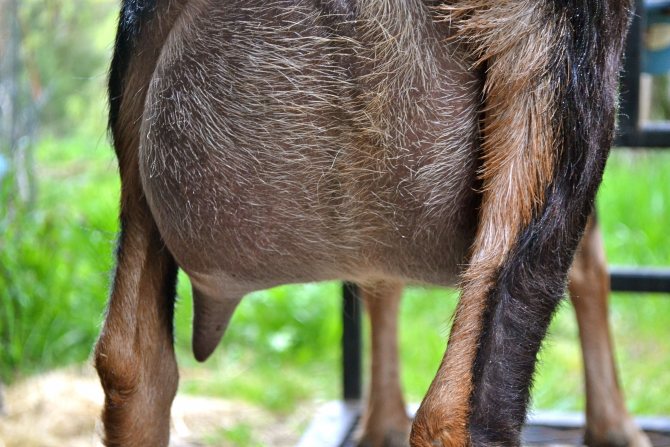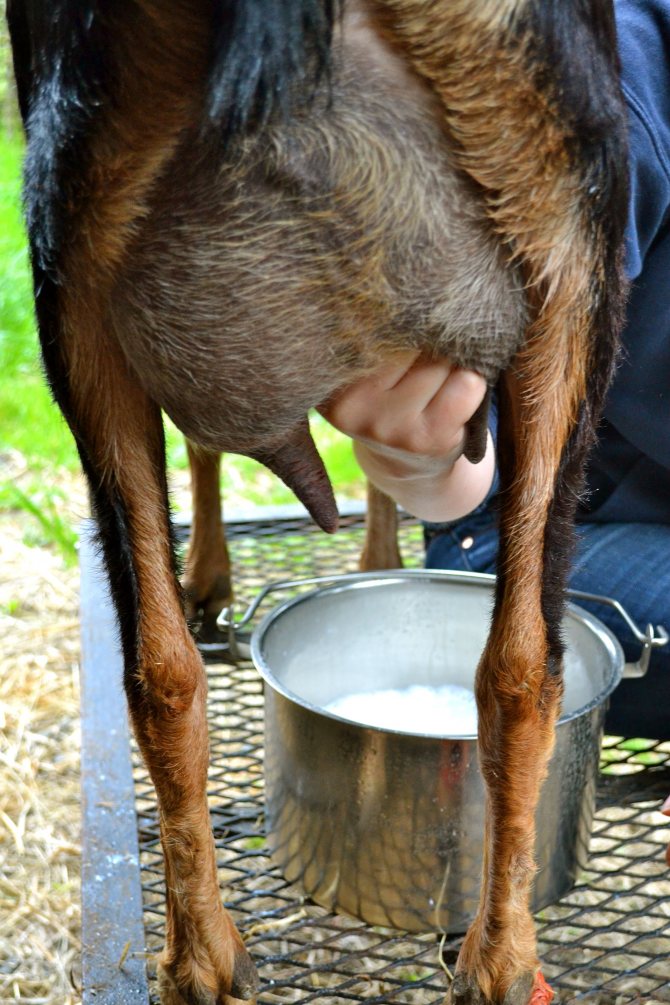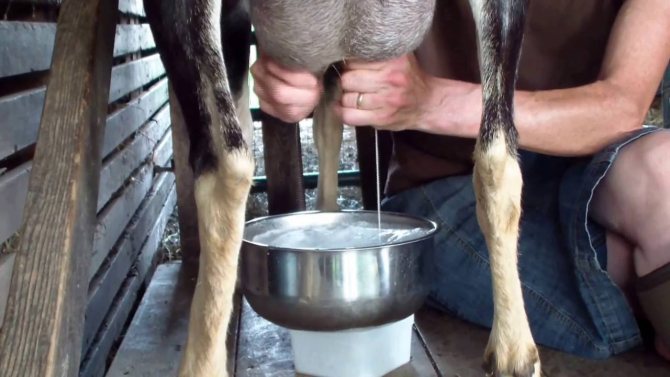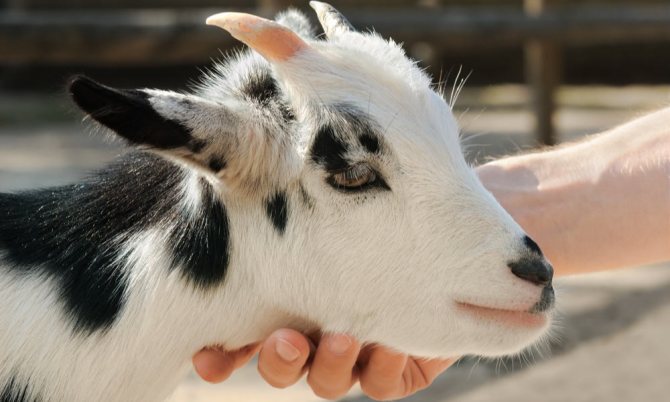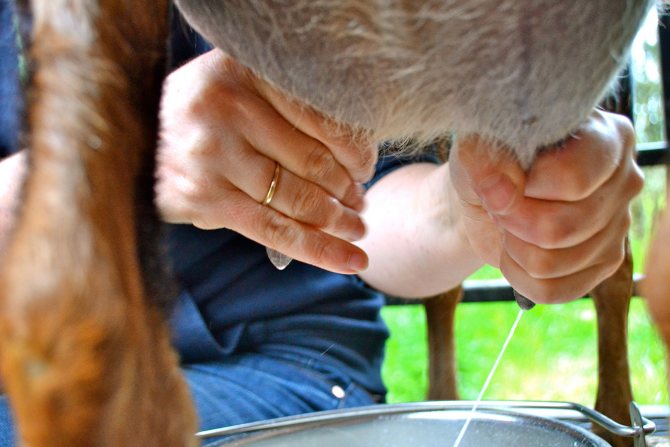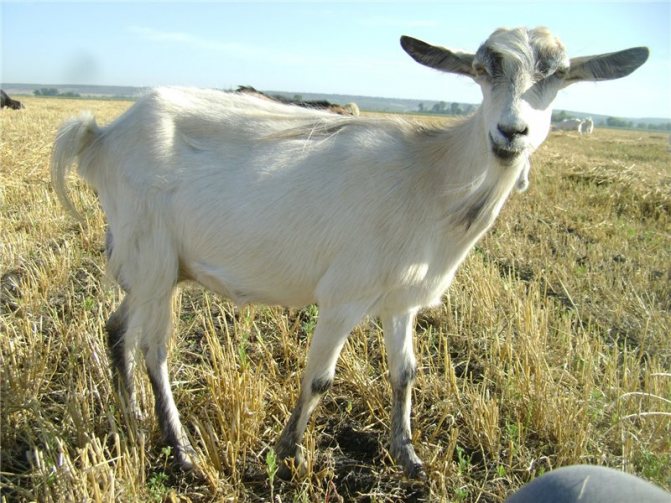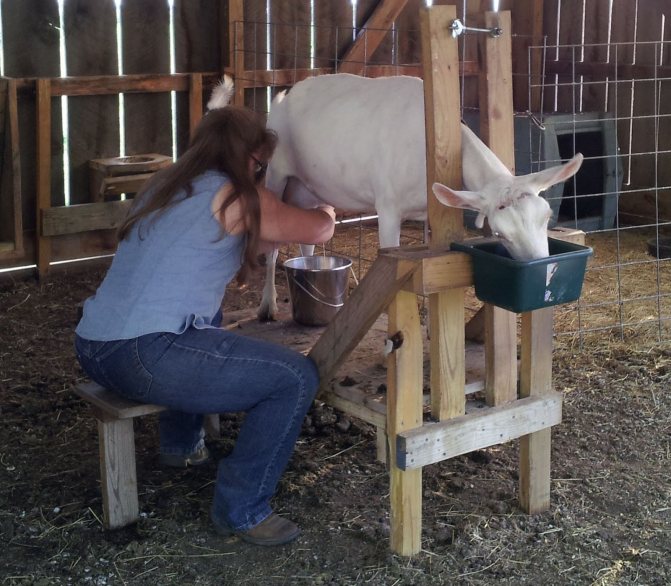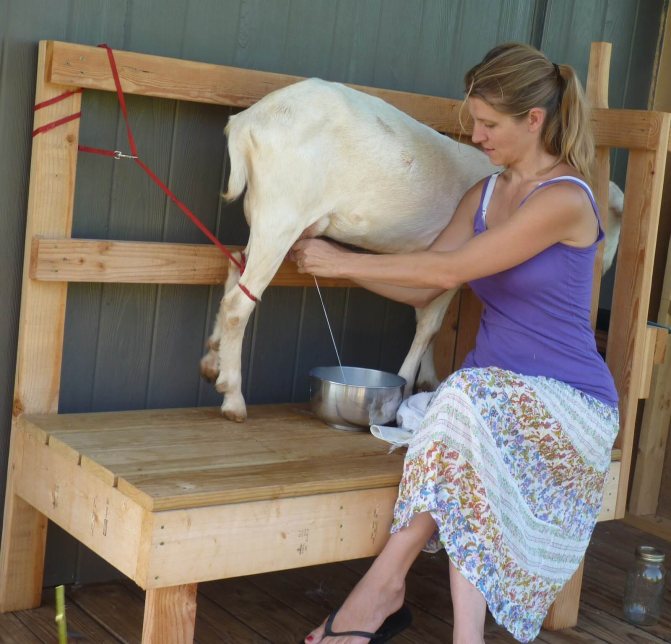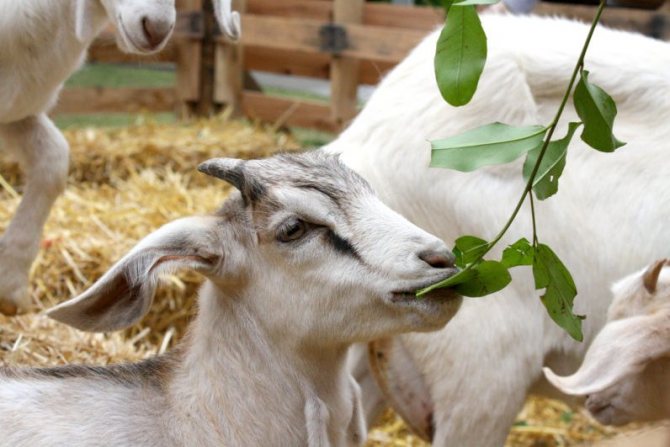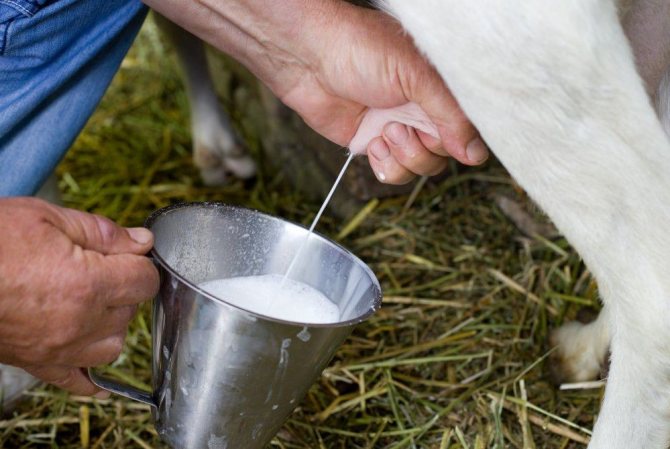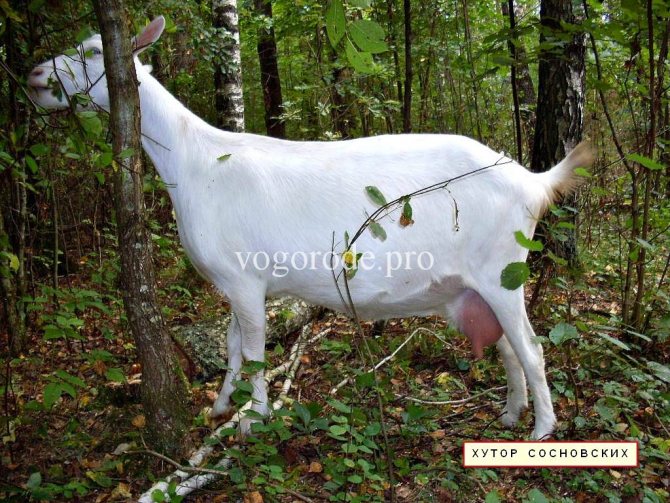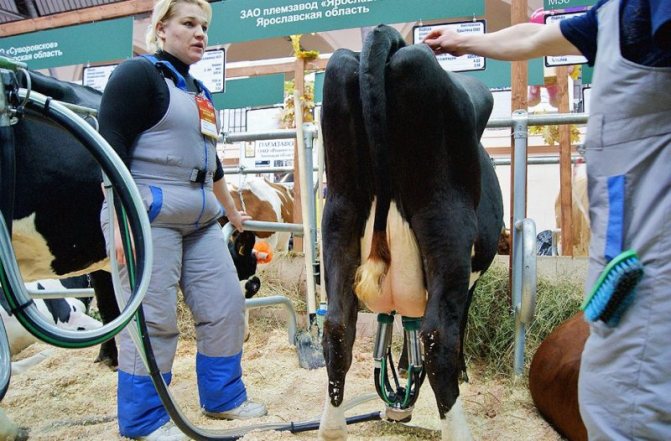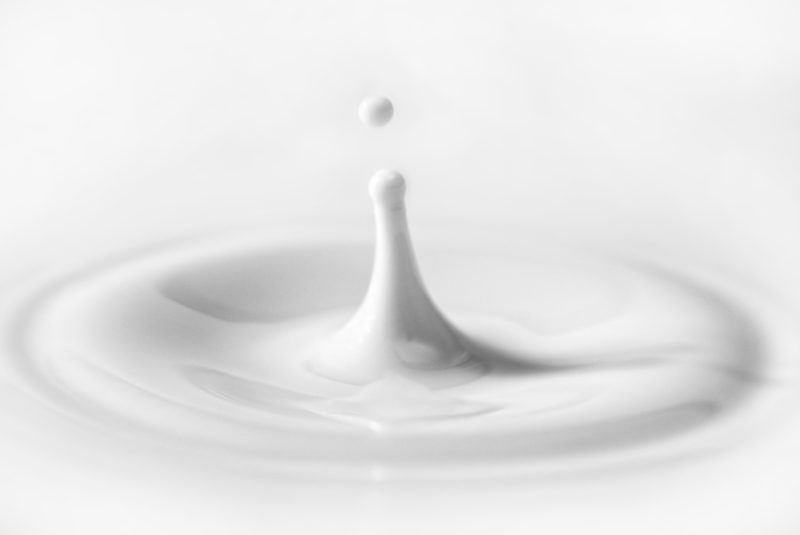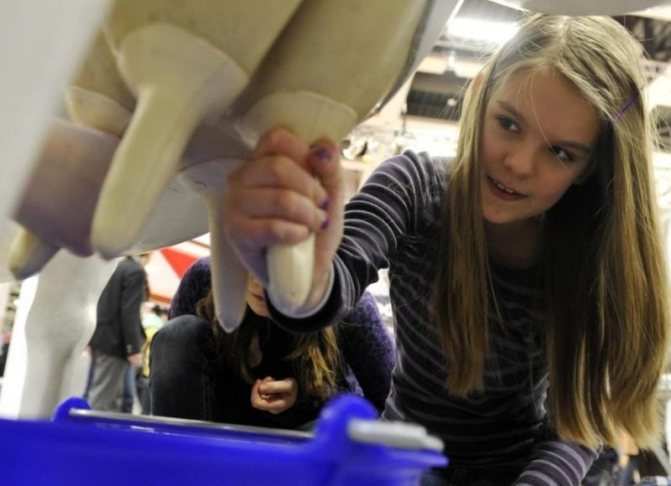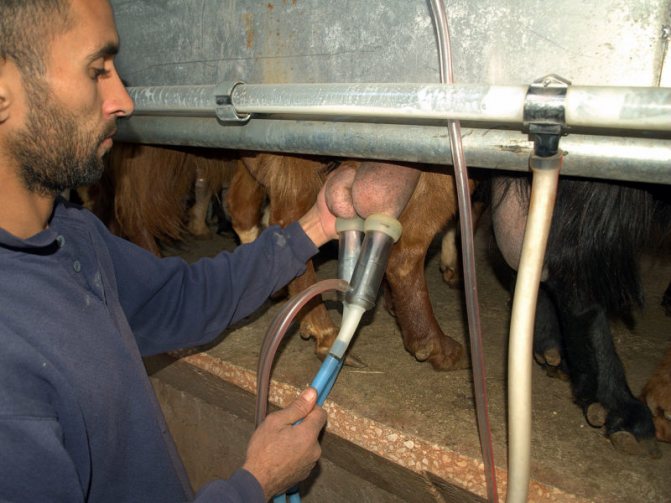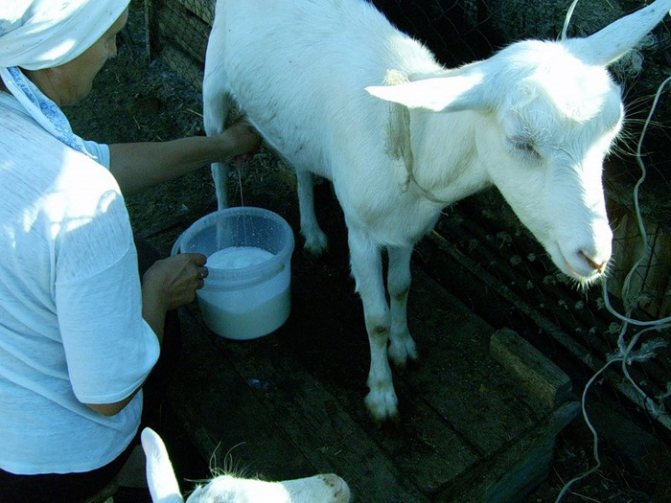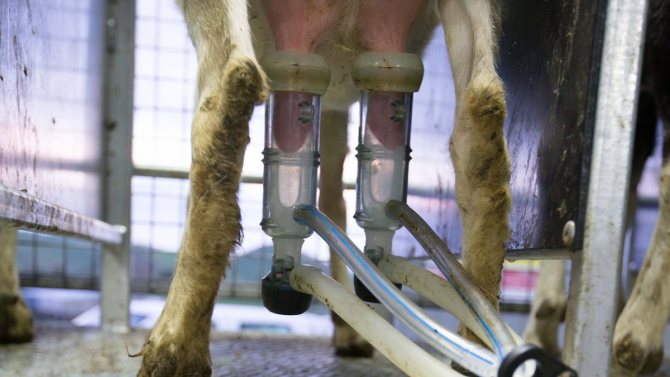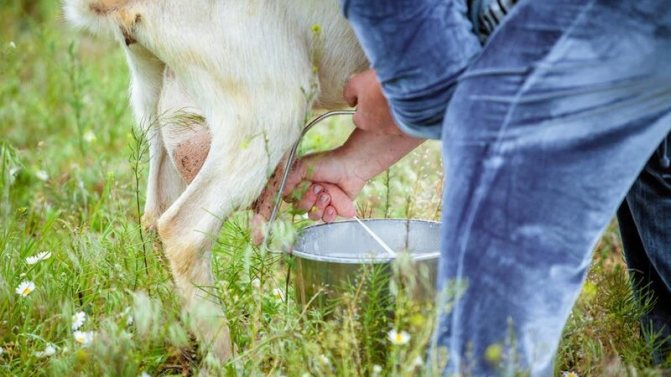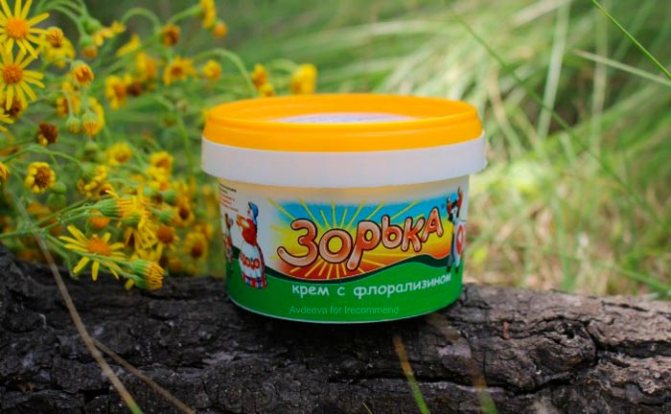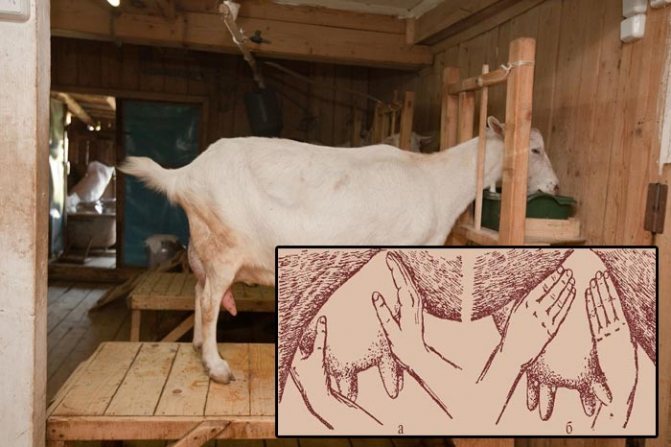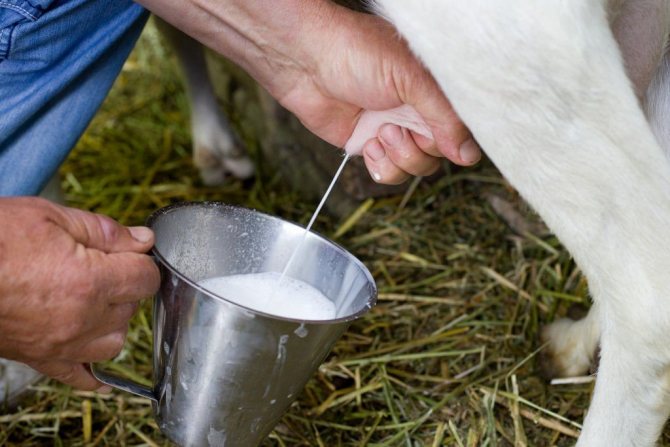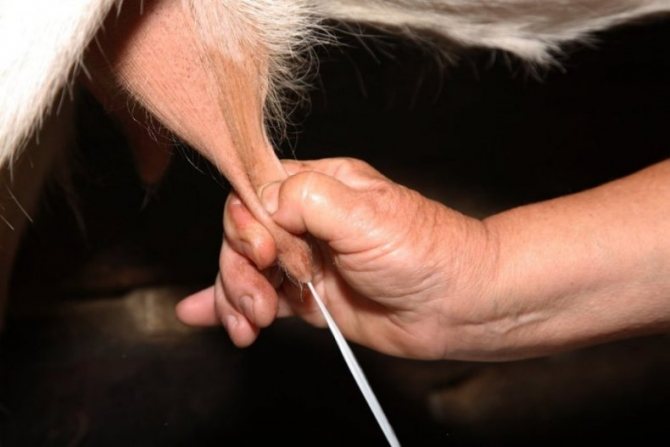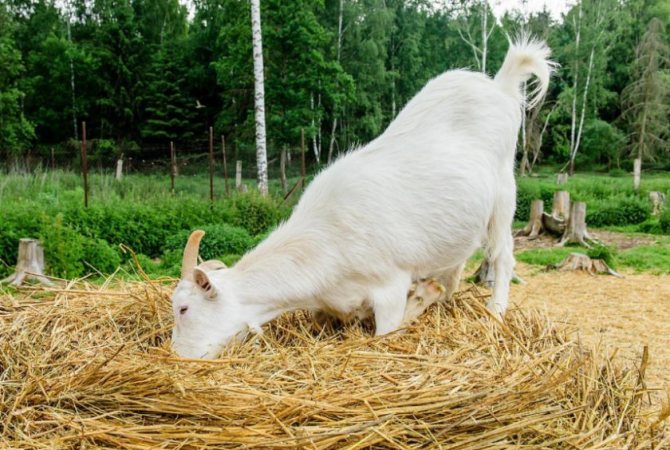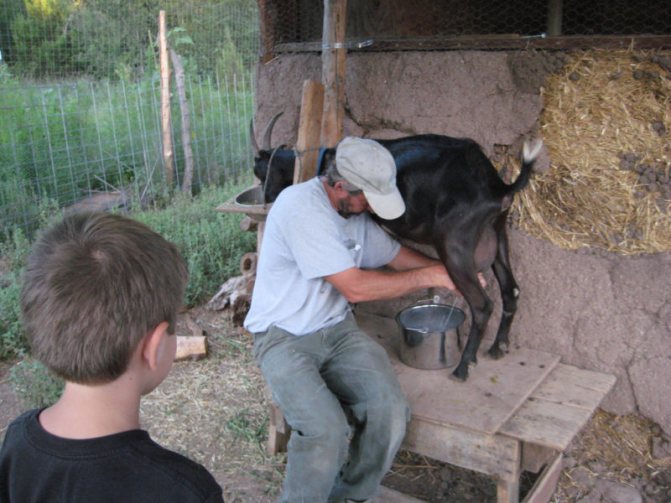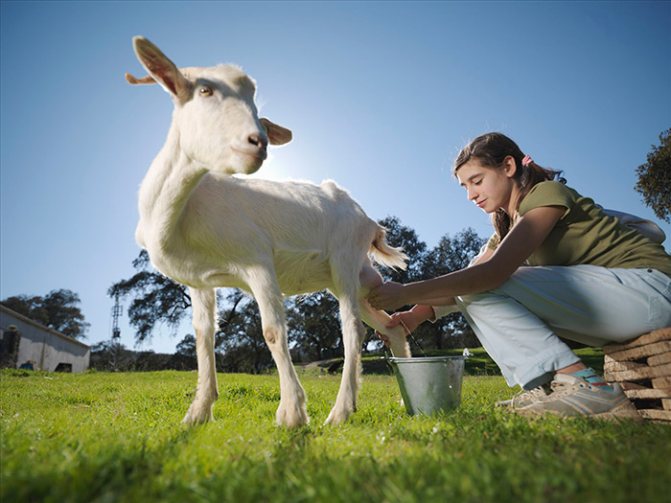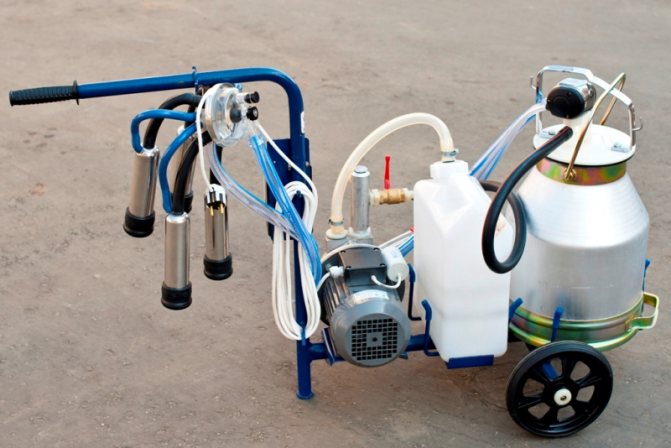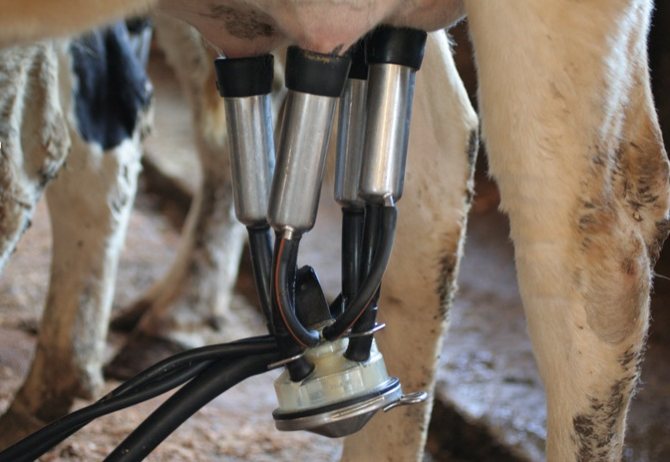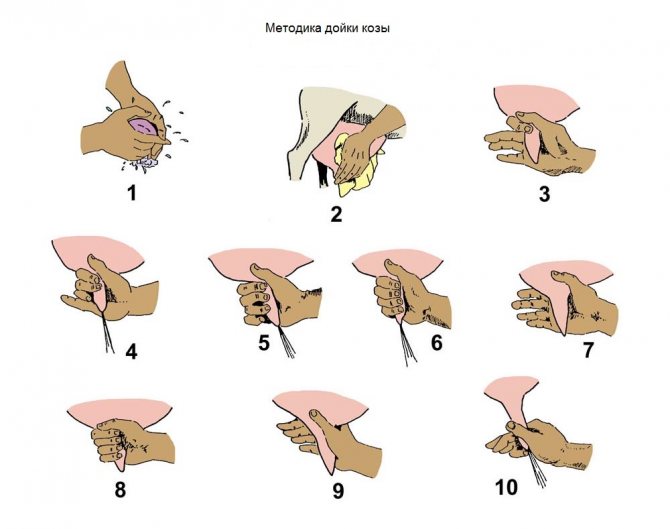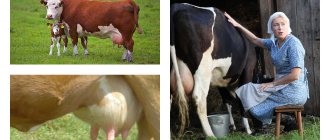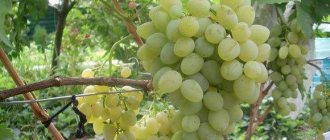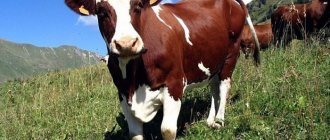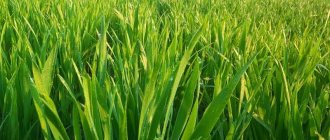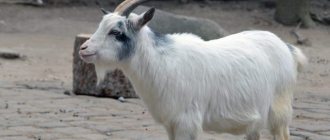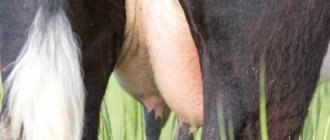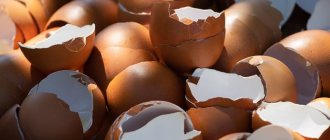The milking process of dairy animals is a cumulative body of knowledge developed over many years of experience. Meanwhile, it is quite difficult for novice farmers to find, so to speak, a comprehensive overview that answers questions about the milking process. It can be referred to as instructions in any situation where consultation is required. In this case, the material is devoted to the question of how to milk a goat or even a whole herd, in what cases, under what circumstances and with what result. So, let's start - how to organize the milking process of one or more individuals.
How to milk a goat
Factors influencing milk production
Like cows, goats have a certain period when they will produce more dairy products than the rest of the time. Cattle yield depends on many factors.
Proper nutrition stands apart in breeding, the weight gain of the animal, lactation, lambing depend on rational feeding. But what to feed? The goat's favorite delicacy is twigs. The quality of milk depends on the inclusion of such a “food product” in the diet.
Choose non-poisonous branches of shrubs and trees, suitable: apple, cherry, plum, birch. In addition to branches, it is advisable to feed the cattle:
- vegetables - not necessarily fresh, the main thing is to thoroughly wash the potatoes, carrots, beets and other products before feeding the artiodactyl;
- root crops - in particular, root turnip must be included in the daily diet of cattle, since this product contributes to an increase in milk;
- grass - individuals get such food on their own, but the owner must carefully choose a pasture for the animal, looking closely at the area, keep in mind that it should not be dry or swampy;
- hay - it must be fresh and of high quality, especially in winter, such feeding will restore the lack of vitamins in livestock;
- cereals - chopped oats, wheat and barley perfectly satisfy the hunger of goats, but you should not give more than 600 grams of grain in one feeding;
- compound feed - if it is not possible to feed the animal with the listed types of feed. Such food is suitable when there is no time to take cattle to pasture, and other types of food are not available.
It is advisable to give the goats mineral and vitamin supplements, as well as water in time. The more pure liquid an animal drinks, the better, since there is a direct relationship between the amount of drink consumed and milk production.
What else determines the milk yield of a goat
- Artiodactyl breed - the Saanen goat species is distinguished by greater lactation than other breeds, take this into account when breeding cattle.
- Age - the old individual will have less milk yield, regardless of other factors, even with a stable feeding, the animal will not please with high milk productivity.
- Heredity - Pay attention to genetic lineage rates.
- Number of lambing - after the third or fourth birth, the female is able to give more milk.
- Health status - it is better to treat or slaughter a sick animal, such cattle will not give dairy products.
Bring the animals to fresh air more often, and it is better to always keep fresh hay in the feeder so that the goats have something to eat.
When lamented
Dairy goat breeds should be milked immediately after lambing. Normal - after 3 months after childbirth. This is due to the peculiarities of lactation. A dairy goat can provide milk to both the kids and the farmer. Usually babies are separated from the mother and fed independently from a bowl of mother's milk. The profit from the sale of milk declines slightly.
Read next: When to shelter grapes in the fall for the winter
For the first week, milking takes place 5 times a day. The kids are fed with mother's milk to increase their immunity. After a month, it is diluted with water and complementary foods are introduced for young animals. At 3 months, the kids do not drink milk, they are transferred to an adult diet.
To increase the milk yield, use vitamin and mineral supplements, adjust the diet. Grain is reduced to a minimum, the daily rate of compound feed and concentrates is increased. The correct milking technique plays an important role in the good performance of your pet.
Milking conditions
The animal should be milked in a well-lit room at room temperature. Milking is a priority in dedicated milking parlors, but a regular pen will also work. Before proceeding, make sure that there is no extraneous noise or drafts in the room. The animal is ready for milking when it reaches one and a half years of age, but not earlier.
Even if the cattle is healthy, you should not immediately milk it, first you need to prepare the goat for the procedure. This should be done a couple of months before pregnancy. Preparing an artiodactyl for milk production consists of:
- in daily udder massage;
- in a balanced diet;
- in washing the udder with warm water and trimming excess wool around.
Before lambing, we stop all these actions, and it is better not to keep the kids next to the female, so as not to damage her udder. It is necessary to feed the babies with mother's milk until they reach three months of age, after which the kids will eat the same as the adults.
After the goat has given birth, it is necessary to milk it 5-6 times a day, and so on for a week, then in the next six months we gradually reduce the number of milkings to two or three times a day. It is important for the farmer to decide on the time, since it is best to milk the animal at the same recommended interval from 9 to 11 in the morning.
Features of preparing hands and udders for milking
Preparation for milking of the one who will carry out it is as follows: remove jewelry from the hands that can damage the udder; wash their hands with soap and put on clean work clothes (the one in which the goat will be milked constantly).
Preparing an animal before milking is reduced to washing the udder. To do this, use warm water.
First, the udder, especially the nipples of the goat, are washed with water, with light massage movements, without causing unpleasant sensations to the goat. You will understand this by the behavior of the goat, it will stand calmly and not kick.
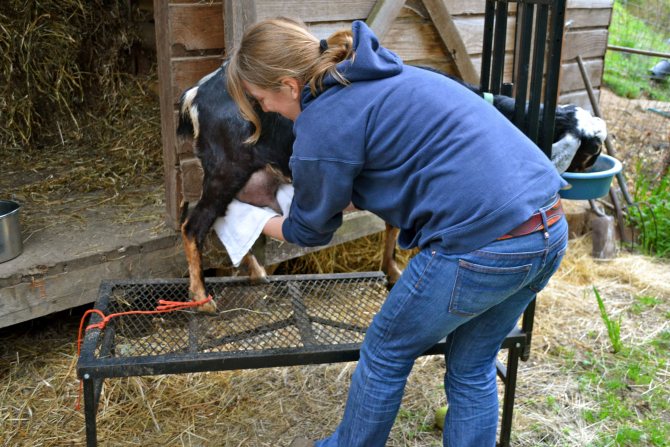
Preparing the udder before milking
It is convenient to dry the udder with a paper towel, but you can also do it with an ordinary clean towel with blotting movements. In the event that the animal has a tendency to overgrowing the udder with wool, it should be removed regularly, as it can cause infection in the milk.
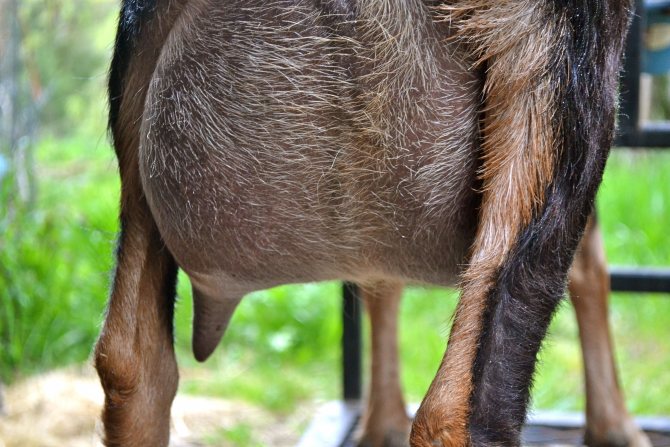

Udder hair must be cut
To improve milk flow, the udder should be massaged before milking. For this, hands are lubricated with a special nourishing goat cream. Then she began one, and after the second share of the udder, gently grabbing, rub. At the end of the massage, they should be slightly squeezed.
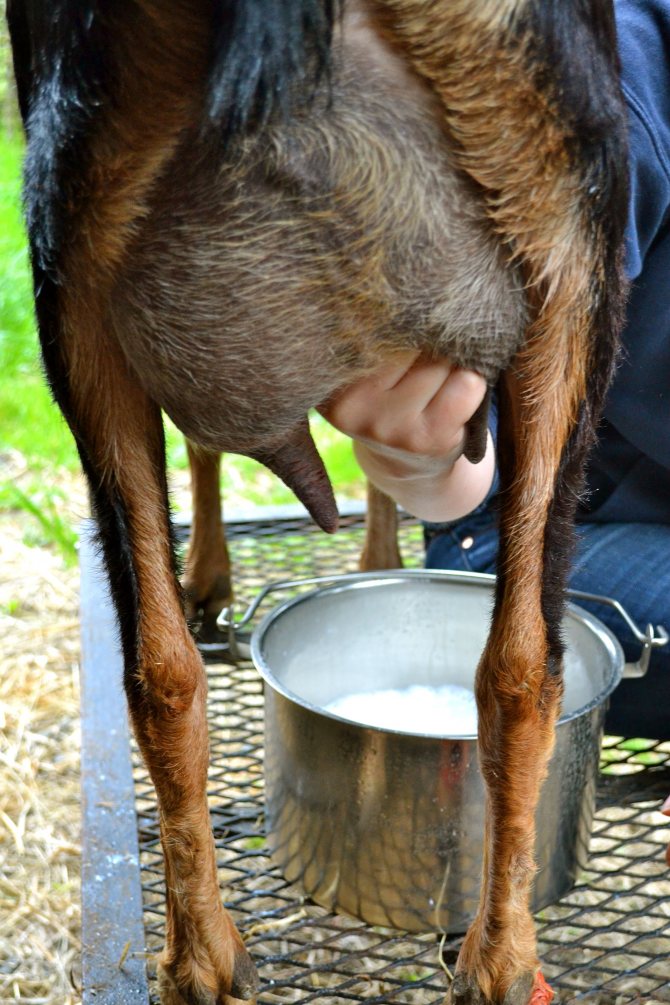

Before starting milking, the goat should be given a small udder massage.
Milking of goats is started only after complete preparation.
Varieties of methods for expressing goat milk
There are two known methods for effectively milking goats: manual and with the help of special devices. For inexperienced farmers, both methods will seem difficult due to ignorance of the technique and nuances of milk yield.
Hand milking
There are several ways to milk a goat by hand, but the most common method is when the breeder is located on the side of the cattle. Before the process, the artiodactyl is fed with branches, hay, and the udder is thoroughly washed. Manual milking is used when the farm is small and the number of cattle is not more than ten. For the manual, it is advisable to purchase a special machine, then it will become more convenient to receive milk from an animal.
Machine milking
If you have acquired a large livestock and seriously expect to benefit from this, then consider purchasing a milking machine. Not all farmers approve of this method, as they do not trust innovations and technologies, but the machine method of milking also has positive aspects:
- the hygiene of the procedure, when compared with the manual method, but the udder massage will still have to be done personally;
- cream is obtained using the apparatus;
- goat's milk is expressed completely, due to the number of pulsations of the apparatus;
- the risk of seizures during milk production is reduced.
The choice of milking method should be based on the health status of the animals, the number of heads in the herd, and not on the basis of personal considerations.
Blood in milk: causes
If the milk has turned pink, the farmer should take a close look at it. Perhaps blood gets there. The reasons may vary.
- Mastitis. Most often, this disease explains the origin of blood in milk. But with it, other symptoms should also be present: seals in the udder, often fever and pain, which the milkman cannot fail to notice. In this case, you should immediately call your veterinarian.
- Increased lactation after lambing. Too much milk is filling the udder and a burst capillary may be causing the milk to turn pink. Then you need to increase the number of milking or adjust the schedule.
- Inexperienced milking. It happens when the udder is strongly squeezed, when an inexperienced person is milking. It is urgent to take skill lessons from a specialist.
- Change of technique or milker. A little blood may be released if one person has been milking for a long time and is suddenly replaced by another, or if the household has decided to milk the goat in turn. Squeezing the udder in unfamiliar places can cause a small amount of blood to flow out. A goat needs to be milked by one person.
- Injury. This is possible when the pet is kept in the same pen with the kids. The cubs need to be resettled.
If the above reasons are not suitable, it is worth showing the goat to the veterinarian, and it is better not to delay the visit.
A clean udder is the key to high milk production
Before milking a goat, the farmer must put on a clean robe, wash his hands with soap and dry them. There should be no jewelry on the hands, we remove all unnecessary - rings, bracelets, watches. The udder should also be thoroughly rinsed with heated, but not boiled water, we pay special attention to the nipples. At the end of the water procedures, dry with a paper or ordinary towel.
Udder massage
The goat should be massaged for 2-3 minutes before milking. It is recommended to process each part of the udder separately, clasping it with both hands and rubbing it on all sides, while gradually lifting the mammary gland up and squeezing it slightly, then lower it down, without stopping to massage. Such procedures are performed up to 5 times a day, from which the milk flow will be higher. The massage will have a beneficial effect on the general condition of the cattle, improve metabolism, blood circulation, and the work of the mammary glands.
For this, it is useful to purchase special preparations that help improve the skin of the udder, these include: Phytosept ointment, Zorka cream, Doctor. These funds protect the skin of an individual from inflammation, sun rays, frostbite, and prevent the appearance of cracks.The drugs are used both for medicinal purposes and for prophylaxis, but immediately before milk production, you should not use these funds, since part of the cream can get into the liquid.
After milking is complete, also massage the goat, wipe the mammary glands with a napkin, and trim the excess vegetation around the udder with scissors so as not to injure and frighten the animal.
Feeding after lambing
After giving birth, the goat is accompanied by a feeling of thirst. Therefore, in advance, at the first sign of lambing, you need to prepare swill for the animal. It can consist of decoctions:
- bran;
- flax seeds.
You can read about the signs of goat lambing in our special article.
It is advisable to give sugar syrup to the mother after lambing, which will make up for the loss of carbohydrates. So the animal will quickly gain strength, recover.
Video - Feeding the animal after childbirth
It is forbidden to give food to the mother immediately after lambing. You need to wait one and a half to two hours after the last kid appears. At this time, water is much more important to her. Fresh, clean water should be drawn every 2 hours. But do not put more than two liters so that she does not drink that much at a time. With such a plentiful drink, udder edema will begin.
The first feeding after lambing should be given to the mother black bread, on which a large layer of bacon or butter should be spread beforehand. After that, you need to give a flour "soup" at room temperature, with the addition of flaxseed oil. These components will help the goat get rid of hunger, give it strength, and will also be very useful and nutritious.
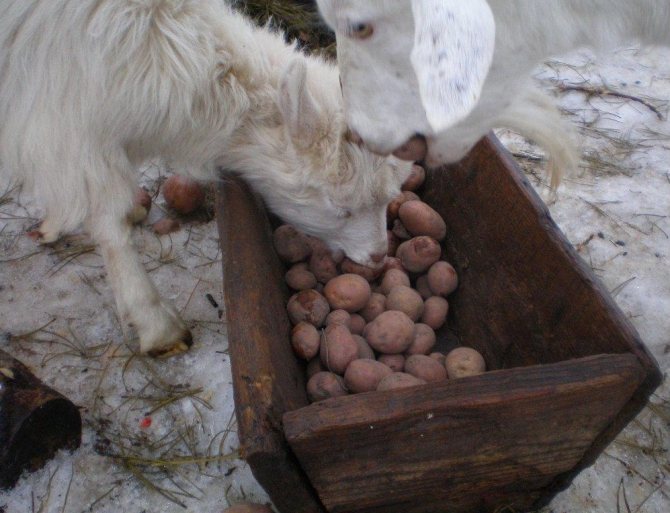

Goats can be given potatoes by boiling them beforehand.
After that, you need to build a diet in such a way as to restore strength and the digestive system of the animal, as well as push the process of milk production. The following components must be added to the mother's food:
- large oats, 220-290 grams;
- pre-chopped carrots;
- good hay, which was cut exactly at the time of flowering;
- table salt, 7-18 grams.
All of these foods should be given in small amounts. In order to increase milk production, you need to give her warm soups with juniper berries.
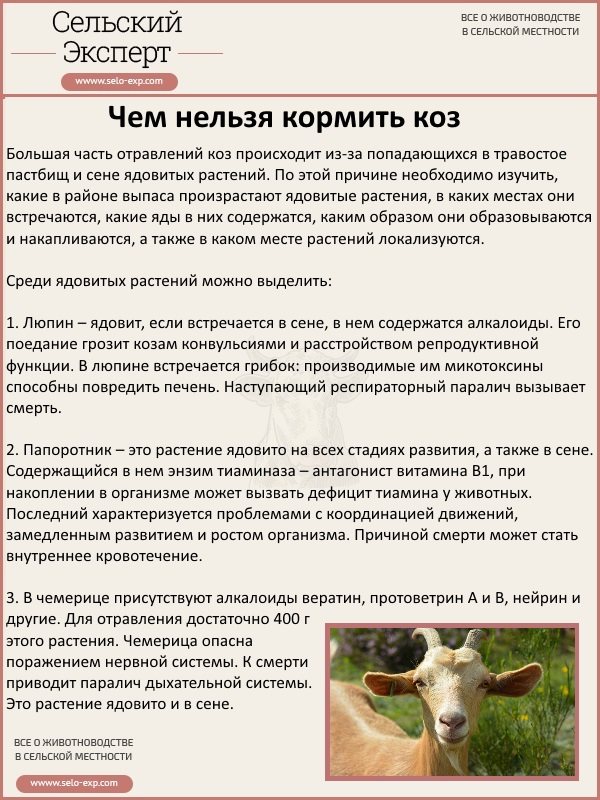

What you can't feed goats
What are the different techniques for expressing goat milk?
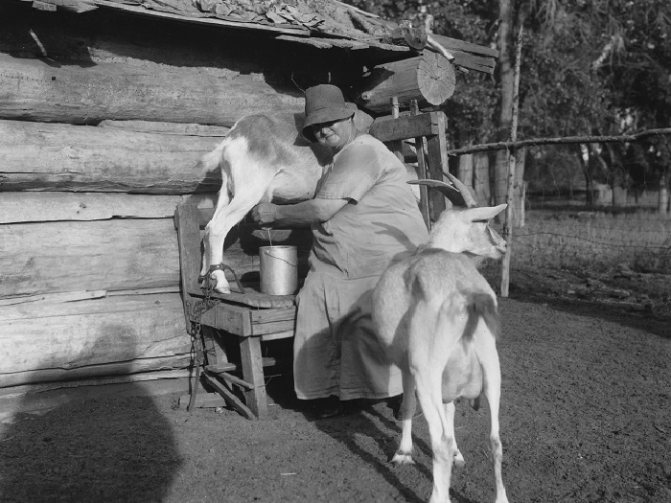

To get more milk, learn an effective technique, because a good farmer must know how to milk a goat with his own hands. If you previously had to work with a cow, this does not mean that the milk yield of a goat will not be difficult, because their udders differ in structure, therefore, the techniques are also different. There are three types of manual milking techniques:
- classic - this is when the farmer stands to the side of the animal, rightly considered the most correct and hygienic technique;
- Moldavian - suitable for non-dairy breeds, in which the glands are poorly developed, the goat breeder is located behind the animal;
- combined method - used to develop the mammary glands of the goat.
Milking techniques should be used depending on the shape of the udder and the breed. If we take a closer look at the techniques that allow you to achieve greater milk productivity, then there are also three types of them: pinch, fist and mixed milking.
Using our fists to milk goats
- First of all, rinse the udder with cold water, then take the papilla with your index and thumb - gently express the milk.
- Gently grab the udder with the ring finger, thumb and little finger, decant the liquid.
- We try to slowly milk every drop of milk, since it is in the last portions that such a valuable and healthy product as goat fat, rich in important microelements and vitamins, is contained.
Interesting
While milking a goat, you will notice how the hand gradually clenches into a fist, hence the name of the technique.
Learning to express milk with a pinch
This technique is suitable when the female lambes for the first time, that is, the method is suitable for young queens. The essence of this method is to neatly grip the udder with three fingers: thumb, ring and little finger, then we begin to slowly, smooth and rhythmic movements, milk the cattle. The pinch milking technique is an intermediate stage, after which they move on to combined techniques.
The essence of the combined method
The mixed method of expressing goat milk is a hypostasis of the two previous techniques. Milk the main portion with a fist, smoothly grabbing the udder, and push the nipples with pinches. The procedure should be performed with gentle circular movements, slightly applying pressure on the mammary glands when the hand approaches the bottom.
If fist milking is used when the udder is large and the mammary glands are developed, and the pinch method is practical for goats that give little milk, then the combined method is suitable if the cattle have medium-sized nipples. Take into account this dependence before milking the goat, and pour out the first 3-4 jets, since it is in them that pathogenic microbes can be found.
If a goat milks itself
Sometimes goats suck out their own milk, leaving a small amount of product to milk. Farmers cope with this phenomenon with the following methods:
- Treatment of nipples with essential oils with a pungent smell. Such a measure will disgust the lactating female, she will stop milking on her own.
- Making a bra for a goat udder (the method is unreliable, animals gnaw them quite easily).
- The postoperative collar for large-breed dogs is worn on the goat, interfering with its actions in relation to the udder.
Most often, a goat cannot be weaned from sucking milk.
Getting your first milk
It is necessary to prepare for the milking of a goat a month before the first lambing. An individual must be prepared for the procedure with the help of a daily short-term udder massage. You can massage the udder with a towel soaked in warm water. It is recommended to start dairy goats, as they are easier to milk after the first lambing. Other species require a special approach, for example, non-dairy goats are milked only 3 months after the first lambing.
If a farmer seriously intends to engage in animal husbandry and plans to receive significant profits from goat's milk, then you need to adhere to certain rules and learn how to properly milk a goat after lambing, for this:
- do not let the kids go to the uterus, newborns are kept in a separate pen, but in such a way that they can see the mother;
- young animals should not drink milk on their own, as they can damage the udder of the female with horns, it is better to feed the babies from the bowl themselves;
- within 5-7 days after giving birth, milk at least 4-5 times a day, it is during this period that the goat gives more milk;
- it is better to tie the individual to the feeder or attach to the machine, and before milk it is worth stroking the animal, giving it food so that it becomes attached to the owner and is not frightened;
- in no case raise your voice and treat the animal gently, as it quickly becomes stressed, which will negatively affect milk production;
Be sure to monitor the condition of the udder and the health of the animal, as sick goats, even dairy breeds, will not bring the expected profit due to low productivity.
How to increase milk yield
After lambing, lactation usually increases naturally. Taking proper care of the goat will stimulate milk flow and she will produce more milk. To do this, you should follow several recommendations.
- Strict adherence to the milking regimen.
- Nutrition is a must. For example, an excess of grain will lead to obesity and, as a result, decreased lactation. Reduces the amount of milk and potatoes, and increases chamomile, turnips, legumes hay.
- Milk should be milked clean, otherwise it, burning out, will reduce lactation, and systematic malnutrition can even cause mastitis of the mammary glands in the goat.
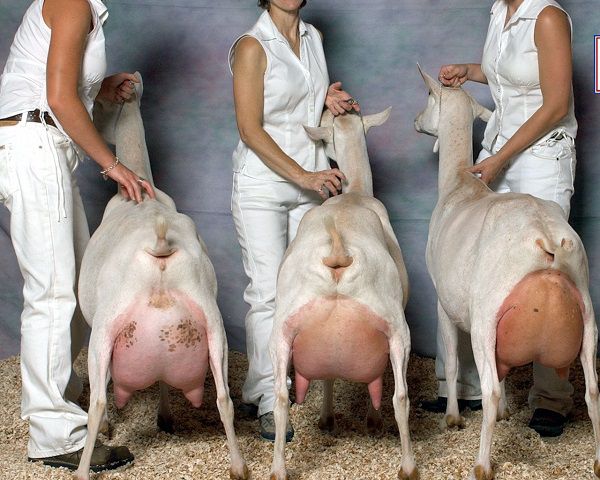

Full nutrition of goats and complete milking of milk will help to increase milk yield.
It is recommended to pinch the goat immediately after lambing. This period is the most dangerous and requires the greatest attention to the animal, since blood may appear in the milk.
What to do if milk yield is low
You should not expect high milk yield from goats, of course, in the first month after lambing, the animal will delight the owners with milk productivity, but then gradually the amount of the product received will decrease. In the best case, the cattle will give 12-16 liters of milk per day, and this applies to dairy breeds. From 3 to 5 liters per day can be obtained from an average lambing female if the milk yield is half this indicator, that is, a reason to think about why the goat has reduced milk.
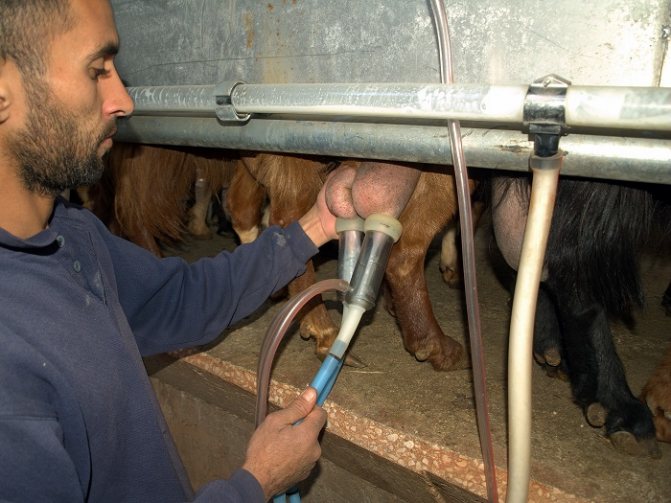

A decrease in milk production is associated with pathologies and depends on physiological factors.
Reasons for the fall in milk yield
- The age of the animal is the main thing that a farmer should pay attention to if the goat suddenly stops giving milk. With aging, irreversible processes occur in the body of cattle, which lead to deformation of the mammary glands, hormonal changes. In this situation, it is unlikely that it will be possible to influence the milk yield; it is better not to torture and slaughter the animal.
- Poor nutrition also affects the indicators of milk productivity, but it is worth noting that very few goat breeders will leave the pet hungry, another thing is that the goat does not receive the necessary microelements and nutrients with food. Lack of protein, vitamins and mineral salts in the body of the uterus will negatively affect milk yield. Poor food is also reflected in the quality of milk, and low milk yield is often associated with a sharp change in diet. For example, if you feed the animal with hay all the time, and then decide to treat the goats with compound feed, then do not be surprised at the drop in milk production, so it is better to change food products gradually, combining the new type of feed with what was given before.
- Intoxication - goat poisoning occurs due to eating poor-quality products, rotten vegetables, poisonous branches or grass, mold entering the body along with food. If there is a suspicion that the animal has been poisoned, immediately contact the veterinarian, because only by timely identifying the cause of the pathology can the individual be cured.
- Conditions of keeping - poor milk yield is associated with excessive humidity, no sunlight in the stall, as well as excessively high or, on the contrary, low temperatures in the room where the cattle stay.
- Inactivity - lack of movement will certainly affect the deterioration of milk yield, so at least 2-3 times a week take the goats for a walk.
- Diseases - every fifth case of agalactia in goats is associated with abnormalities of the udder and genitals. The complete absence of milk is one of the signs of mastitis, a disease in which the tissues of the mammary glands become infected. Simply put, mastitis is an inflammatory disease of the udder. When an illness is suspected, conduct a complete clinical examination so as not to put the animal at risk.
The decline in milk production is sometimes associated with the preparation of artiodactyls for the next season of intercourse and bearing offspring. The female's body prepares itself for the upcoming difficulties, depositing fats and nutrients necessary for recovery after childbirth.
When do goats start giving milk?
Having a goat's udder does not mean that it will be a continuous source of milk. To become milking, the goat must first become pregnant and give birth to offspring. The goat's first milk is given after the first lambing. The goat's body produces milk to feed the goat, but thoroughbred high-yielding goats give so much milk that it is enough for personal consumption.
There are two options for raising offspring:
- Separated from the mother goat. The kids are given part of the milk, and the rest goes into business - for sale, making dairy products, etc.
- Together with the goat. Milking the goat begins in 3-4 months - after the kids are transferred to regular feed. We also recommend reading the article on how to feed the kids.
Before lambing - in a few days, the udder grows fat, acquires elasticity. The goats are milked after lambing, before that, the udder is only washed and lightly massaged - to improve blood circulation. After lambing, the goat is milked for 6-7 months, maximum - 9. In the last months, milk becomes less, it loses in quality and fat content.
After 6-9 months, the goat ends the milking season, and in order to become a source of milk again, she has to bring a litter again.
Downy and meat goats give very little milk - there is barely enough milk for the offspring, so they are not milked after lambing.
Goat Breaking Secrets
Experienced farmers advise you to start distributing goats outdoors rather than indoors. Before starting the procedure, greet the animal, stroke it, comb it. Although goats are classified as production cattle, they, like pets, love care and attention, so make sure that the individual becomes attached to you.
Some breeders will wonder if there is a way to milk a goat without lambing. Indeed, milk can also be obtained from a nulliparous female, for this the following conditions must be observed:
- daily at the same time, massage the udder of the cattle, for 2-3 months, while simulating distribution;
- gradually the animal will give milk in small portions, the milk yield will increase each time;
- be sure to feed the nulliparous goat with fresh hay and balanced food, take it for walks more often.
Milking a goat that gave birth better, then there will be more milk, and the process of expressing itself will not take much time. It is not difficult to master the correct milking technique:
- press any of the nipples with your thumb and forefinger at the very base;
- start slowly and, keeping the rhythm, press on the nipple with all your fingers.
If the nipples of the uterus are short, then for milking we use only the thumb and forefinger.
Milk yield after pregnancy failure
Premature birth or false lambing in a goat should not be a cause for concern and will not affect milk production. There are no special rules and techniques for queens who gave birth ahead of time. Use the same milking methods as you would normally when the animal gives birth on time and without problems.
Important
If the female has given birth to dead kids, immediately donate milk, such a product can be eaten only after careful processing and approval of the veterinarian.
What herbs to feed a goat to increase milk yield
When feeding, the farmer should pay attention to the lactating properties of some herbs. The preparation and collection of plants for feed is carried out in the summer. Herbs such as maral root, comfrey, rhubarb, hogweed, alfalfa, fennel, nettle are recognized as milk-producing herbs. These plants can be grown in your garden and served dry as well as fresh. Also, silage should be present in the diet all year round, then there will be no hassle with milk yield.
Some food products will only bring harm when ingested, even with their seeming harmlessness. It is strictly not recommended to feed the goat with celandine, since this plant contains poisons that are dangerous to the animal's body and will cause poisoning. Sugar-containing foods and berries contribute to indigestion, so do not feed your goat with such food. Bird cherry branches will also harm the animal, but it is not necessary to completely exclude them from the goat's diet, the main thing is to comply with the norm: no more than 300 grams of bird cherry branches mixed with the branches of other trees per day.
On the frequency of milking per day
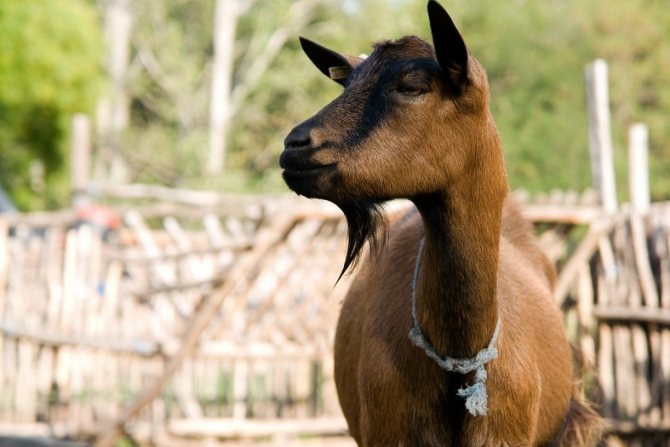

Studies have shown that a goat can produce different amounts of milk depending on the period of life. The highest productivity will be observed during the second and third months of lactation. In summer, the animal produces more milk than in winter, therefore, light and sun rays also affect the milk yield. So how many times to milk a goat per day? Milk should be expressed at least 2 times a day, in the morning and in the evening, at the same time.
Milking theory and practice
The question of milking may arise before a farmer or owner of a private household farm as a result of several cases: after the acquisition of adult goats or the birth of babies from their queens. Goats in households are mainly bred for milk, for this reason it is recommended to have individuals of special dairy breeds. A key feature is milking and obtaining high quality milk over a long period of 9 months (about 305 days).
Dairy breeds are most often found on farms
Dairy breeds
The most productive is the Swiss Zaanen breed, these are the largest representatives in the world. The mass of females reaches 50 kg, and the height at the withers is 77-78 cm, the weight of males reaches 90 kg. The breed reaches puberty early and is very fertile, after the first lambing it gives 3.5 liters of milk per day. 280-300 milking cycles are allowed per year, during which at least 650 liters of milk with a fat content of about 4-4.5% can be obtained. The latter indicator depends on the season and the diet of the animal. The average daily milk yield sometimes reaches 8 liters.
Young Saanen Goat
Large milk yields are given by the Swiss Toggenburg breeds, from which 800-1000 liters of milk with a fat content of 4% are obtained from them per season. The milking volume of one female can reach 1200 liters. These animals still have a rather long coat - about 20 cm, which can be used for making warm woolen products. It is suitable for breeding townspeople who are afraid of horned animals. The breed is considered hornless; in some cases, the goat may have small horns.
Toggenburg goats
In Russia, the Russian white goat breed is popular, which gives more fatty milk with a fat content of up to 4.5-5%, and the total milking volume per lactation season (8 months) is 400-500 liters. Also popular is the unpretentious Gorky hybrid, obtained by crossing the Zaanen breed and local ones. As a result, you can get milk with a fat content of 5% with a milk yield of up to 500 liters per lactation season. This breed is suitable for the cheese-making business.
Dairy breed Russian White in the pasture
Milking goats and their features
What are the hallmarks of a good milking goat:
- exterior features: small head, compact size, small transparent ears and straight back, large chest;
- udder and udder veins: without varicose veins, hematomas, with a fine and delicate vascular network, well-developed veins, large and well developed. Veins should go up the belly, forming "wells", the larger the number and size of wells, the greater the milk yield of the selected individual;
- weight - up to 60 kg.
Calendar year of dairy goats
A number of other dairy breeds can be found in Russia: Cameroon, Alpine, Anglo-Nubian, and Valdai. Higher quality milk is usually produced by hybrids. The quality criteria for milk include the absence of odor. It is worth listing the breeds that give odorless goat milk:
- Zaanenskaya;
- Toggenburg;
- Russian white;
- Alpine;
- Cameroon;
- Megrelian.
Gorkovskaya and Anglo-Nubian the breed gives a faintly perceptible smell of milk; not all people are sensitive to it. In addition, washing the udder thoroughly helps to remove residual aftertastes.
Dwarf Cameroon Goat
The Cameroon goat belongs to dwarf breeds, ideal for small household farms (houses in the city), the average daily milk yield is 1.5-2 liters. Lactation lasts 4-5 months, lambing - up to 2 times a year, milk fat - over 5.3%.
Boer goats
The Boer breed is meat and dairy, in addition to milk (up to 2 liters per day), you can get premium quality meat, it is often supplied to expensive restaurants and other establishments. These animals are distinguished by their unpretentiousness and adaptability to hot climates. Mountain Altai goats are bred as downy goats. Milk is used to feed young animals.
Video - Milking Saanen goats
How to calm a goat's anxiety while milking
Before milking, make sure that the individual has time to become attached to you. It is necessary to pacify the animal by stroking, with a good-natured soft voice. Tie the female to the milking parlor, in the first 5-6 days she will be uncomfortable, but after that the cattle will get used to it, and milking her will not be a problem.
If the goats are alarmed during milking, pay attention to your hands: nails should be cut, there should be no abrasions on the fingers, scratches that can injure the nipples. Be sure to feed the goat before and after milking, and after finishing, brush the udder with Vaseline.
How to increase the amount of dairy products
In order for the goat to give milk, it must be properly fed. To increase milk yield, farmers use certain types of feed in their diet.
Thanks to root crops and vegetables, milk production is significantly increased. The most ideal delicacy in this case would be turnips. Fresh branches are in the second position, while it is not recommended to give poplar branches: they affect the taste of milk (a bitter taste appears). In the summer, it is necessary to give green mass, replacing hay with it.
It is important for lactating goats to have clean and fresh water available at all times. In winter, it is best to use a warm liquid for drinking. Drinkers must be rinsed daily.
Milking with machines
Milking machines allow you to get milk from production animals in a short time. Manufacturers offer equipment for both small livestock and flocks of 10 or more goats. Mini milking machines are able to alternately express milk from 7-9 goats within an hour. The devices are simple to use, the principle of operation is to cause compression of the nipple by mechanical action on it, thus collecting milk. The use of a milking machine will reduce the likelihood of injury to the udder by 3 times, and facilitate the work of the farmer.
Application rules
Before using the device, read the instructions carefully, as milking machines differ in both characteristics and rules of operation. Basic rules on how to properly milk a goat with a device:
- the device must be disinfected, check if there is a vacuum in the nipple cups;
- we tie the goat to a rack or machine;
- wash your hands, give the cattle some feed;
- wash the nipples of the goat with warm water, it is also advisable to use antimicrobial agents for rubbing the udder;
- we massage the udder of the cattle, and collect the first trickles of colostrum in a separate bowl;
- wipe the nipples with a napkin or paper towel, but do not use wet wipes for these purposes, so as not to provoke inflammatory processes;
- we carefully put the cups on the nipples of the goat, then we apply a vacuum, we monitor the flow of liquid;
- immediately disconnect the device from the nipples, if milk has ceased to be expressed, then milk the animal manually to prevent pathologies.
After use, the device must be disinfected again with antibacterial agents and rinsed thoroughly. We give the animal some food and drink with clean water, send it to the herd.
Hand milking
On a farm with no more than 10 goats, milking is usually done by hand.The most rational sequence of the process has been worked out over many years of practice, which made it less tedious. The goat for milking should be put into the machine and put in the feed trough for her to be distracted by it. If goats kick during milking, they can be weaned from this by putting the goat's favorite treat into the trough every time they are milking.
The owner sits on the side of his pet and, grasping the nipple at the base with his thumb and forefinger, squeezes pushing the milk from the nipple down several times until the moment milk begins to flow. The first trickles are taken into a separate bowl, since they should not be eaten. After all the milk has been milked, lightly massage the udder of the goat and try to milk the last drops.
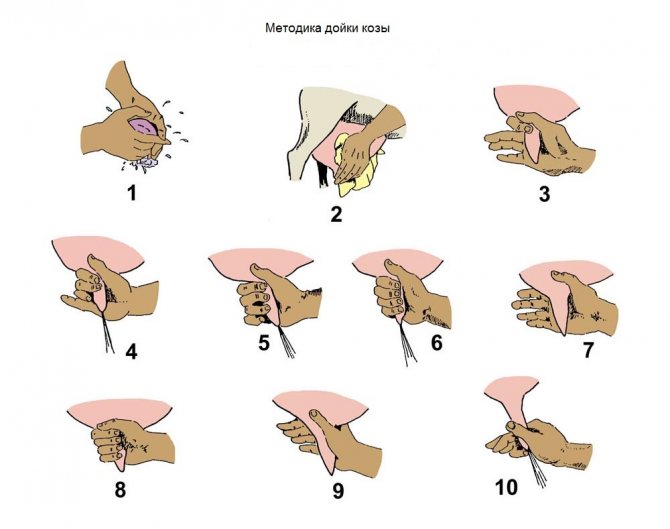

Goat milking technique
After milking, the udder is massaged for 10 seconds and blotted dry with a towel. If the care of the pet is correct, then the goat gives milk regularly and without difficulty.
Prevention and treatment of mastitis in goats
The most common disease in goats is mastitis. Inflammation of the mammary glands occurs due to pathogenic bacteria, the influence of harmful chemicals or mechanical injuries of the udder. The symptoms of the disease are as follows:
- an increase in temperature at the site of the lesion - if you take the udder in your hands, it will be unnaturally hot;
- there is an increase in the lymph nodes of the animal;
- the cattle will experience pain when the owner takes the udder in his hands, because of this, the goat may scream;
- the mammary glands fester;
- complete decline in milk production;
- blood can be observed in milk.
If you find any of these signs, contact your veterinarian to take action to correct the disease.
How to diagnose
Diagnosis of the disease should be carried out after a month from the moment of lambing, and then every three weeks, repeat the procedures until the lactation period has passed. Experienced farmers, in order to recognize mastitis, pass the first streams of milk through a sieve, if at the same time the formation of mucous masses, ichor is observed, then these are true symptoms of pathology.
Every year, carry out a diagnosis of goat milk to identify microbes, an experienced veterinarian will help to do the analysis.
About precautions
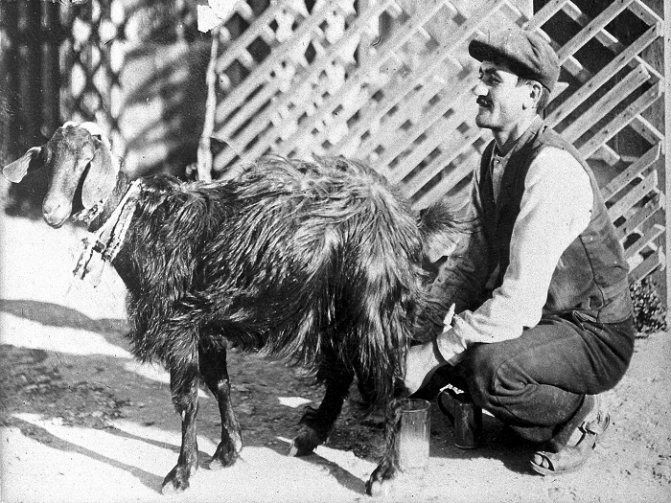

- The animal should not lie on damp, cold ground, the recommended temperature in the stall is 12-15 degrees.
- Change the bedding underneath the livestock every day to keep bacteria out of the udder.
- Aim for full milk yield as the leftover milk decomposes and leads to inflammation.
- Drink only warm water.
- Disinfect the goat's teats after expressing milk again.
- Do not take your animal for a walk in rainy or cold weather.
- Try to give roughage and root crops every day.
- When milking a goat at home, do not forget to pre-massage the cattle.
There are several forms of mastitis in goats, a purulent type of disease is considered dangerous, when festering growths form on the udder. Be sure to treat the animal on time, if the pathology is started, then the therapy will take a lot of time and money.
To consistently receive high milk yield, take care of the animal, learn milking techniques, and monitor the health of the cattle.
Pregnant
It is not recommended to milk pregnant first-born goats due to possible hormonal imbalance. The animal strengthens the body before giving birth and feeding babies. The farmer monitors the diet of the expectant mother, includes many vitamins and nutrients in it.
One and a half months before lambing, it is necessary to start preparing the udder for lactation. It is necessary to teach your pet to touch in the udder area by stroking and hygienic processing. She should be calm while milking.
In a goat that has given birth more than once, milk collection is stopped 2 months before giving birth (the body is gaining nutrients).
If the female is not prepared for lactation, there is a possibility of frequent recurrent mastitis. A lot of foam will form in milk, its useful functions will decrease.

